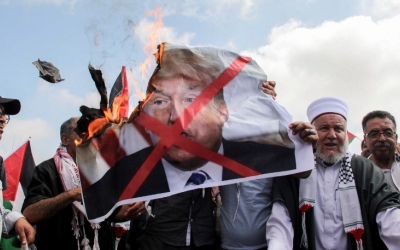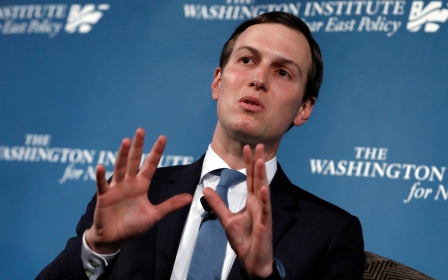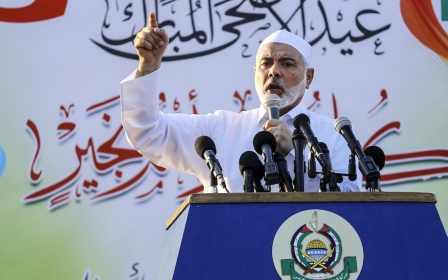Israeli newspaper reveals leaked document of Trump's ‘deal of the century’

Israeli newspaper Israel Hayom on Tuesday leaked details of an alleged document that was part of Donald Trump's "
Middle East Eye could not independently verify the content of the leaked document, whose source was anonymous.
Israel Hayom said that some of the terms of the document have been mentioned by President Trump's Middle East advisor and son-in-law Jared Kushner and his advisor on Israel, Jason Greenblatt, in their informal talks with Israeli officials.
The newspaper is close to Israeli Prime Minister Benjamin Netanyahu, who maintains an amicable relationship with Trump, Kushner and Greenblatt.
According to the leaked document, the
New MEE newsletter: Jerusalem Dispatch
Sign up to get the latest insights and analysis on Israel-Palestine, alongside Turkey Unpacked and other MEE newsletters
A Palestinian state called "New Palestine" would be established on lands in the now-occupied West Bank and Gaza Strip after the signing of the agreement. An election would be held after a year and Israel would start releasing Palestinian prisoners gradually over the course of three years.
The fate of Jerusalem
Regarding the fate of Jerusalem, which Trump's administration recognised as the Israeli capital in December 2017 and where it moved the US embassy in May 2018, the document said the holy city would remain undivided but responsibilities would be shared between Israel and "New Palestine" - with Israel maintaining general control.
Palestinian residents in Jerusalem would be citizens of the Palestinian state, but the Israeli municipality of Jerusalem would remain in charge of matters related to land. "New Palestine" would pay taxes to the Israeli municipality and in return be in charge of education for Palestinians in the city.
The Palestinian population in Jerusalem is estimated to number around 435,000. Palestinian Jerusalemites currently hold permanent residency documents - which Israel can revoke if they live outside the city for a certain period of time - and are not qualified for any citizenship rights.
Since 1967, Palestinians have boycotted municipal elections, as they see them as a part and parcel of Israel's occupation of the city.
The
Meanwhile, Israeli settlements in the West Bank - which are deemed illegal under international law - would formally be recognised as part of Israel.
Gaza Strip
According to the document, Egypt will offer lands near the Gaza Strip for the "New Palestine" state to build an airport, factories and serve the commercial and agriculture sectors, without allowing Palestinians to reside on these lands.
The Egyptian lands to be included in the
A highway would be built 30 metres above ground across Israel to connect the now-isolated Gaza Strip and West Bank. China would pay 50 percent of the highway's cost; South Korea, Australia, Canada, the US and EU would each pay 10 percent.
The leaked document indicated that the US, EU and unnamed Gulf states would fund and sponsor the
According to the document, the US would pay 20 percent of the cost for such projects, or $1.2bn per year, the EU 10 percent, while the unnamed Gulf states would fund the lion's share of 70 percent.
By comparison, the United States currently grants Israel $3.8 billion per year in military aid as part of a record-breaking ten-year
"New Palestine" wouldn't be allowed to create an army, only maintaining a police force. A protection treaty would be signed between Israel and "New Palestine" stating that the fledgling state would pay Israel to defend it from eventual foreign attacks. Arab states would also contribute to payments to Israel in exchange for New Palestine's protection if needed.
Punishments and money
Once the
The Gaza Strip's borders would reopen to commerce with the outside world through Israeli terminals and crossings. Until a seaport and an airport are built on Palestinian lands, Palestinians would be able to use Israeli airports and seaports.
The leaked document stated that the PLO and Hamas would face "punishments" if they refused to sign the deal - saying that the US would cease to fund any and all projects benefitting Palestinians and would ask other parties to do so.
The US already cut all its funding to the UN agency for Palestinian refugees, UNRWA, last year, and has also halted funding for Palestinian hospitals in Jerusalem.
If the PLO signed the
If Israel refused to sign the d
Middle East Eye delivers independent and unrivalled coverage and analysis of the Middle East, North Africa and beyond. To learn more about republishing this content and the associated fees, please fill out this form. More about MEE can be found here.





